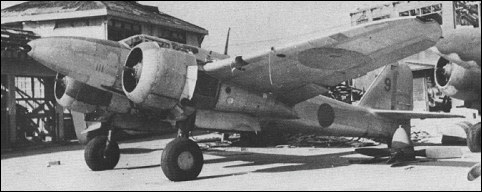|
| Derived from the Ki-96 twin-engine
single-seat fighter, development of
which was abandoned after three prototypes
had been completed, the
Kawasaki Ki-102b was intended as a
two-seat attack fighter for primary deployment
in the close-support role.
Some assemblies of the Ki-96 prototypes
were incorporated into the
three Ki-102 prototypes, the first of
which was completed in March 1944. A
cantilever mid-wing monoplane with a
conventional tail unit, retractable tailwheel
landing gear and two Mitsubishi
Ha-112-11 radial engines, the Ki-102
accommodated its two-man crew in
separate enclosed cockpits in tandem,
Completion of the prototypes was followed
by the construction of 20 preproduction
aircraft and in October
1944 the type was ordered into production.
With the Imperial Japanese
Army still anxious to procure a twin-engine
high-altitude fighter, Kawasaki
modified six of the preproduction Ki-
102s to serve as prototypes of such an
interceptor. This differed from the
attack fighter by having improved two-seat
accommodation, a revised tail unit
and Mitsubishi Ha-112-IIru engines
with turbochargers. Successful testing
of this version in mid-1944 resulted in a
high-priority production order, but
problems with the turbocharged engine
resulted in only about 15 being
delivered to the army before the war
ended. The design had also been revised
to produce a night-fighter version
under the designation Ki- 102c, but
there was only time to complete two
examples. These had increased wing
span, a lengthened fuselage, redesigned
tail surfaces, primitive AI radar,
and armament comprising two 30mm
Ho-105 cannon in the underfuselage
and two 20mm Ho-5 cannon mounted
obliquely in the fuselage to fire forward
and upward. Ki-102b aircraft,
which were allocated the Allied codename
'Randy', saw comparatively little
service, some being used in action
over Okinawa, but the majority were
held in reserve in Japan.

| MODEL | Ki-102b |
| CREW | 2 |
| ENGINE | 2 x Mitsubishi Ha-112-II, 1125kW |
| WEIGHTS |
| Take-off weight | 7300 kg | 16094 lb |
| Empty weight | 4950 kg | 10913 lb |
| DIMENSIONS |
| Wingspan | 15.57 m | 51 ft 1 in |
| Length | 11.45 m | 38 ft 7 in |
| Height | 3.7 m | 12 ft 2 in |
| Wing area | 34 m2 | 365.97 sq ft |
| PERFORMANCE |
| Max. speed | 580 km/h | 360 mph |
| Ceiling | 13500 m | 44300 ft |
| Range | 2000 km | 1243 miles |
| ARMAMENT | 1 x 57mm cannon, 1 x 12.7mm machine-guns |
 | A three-view drawing (752 x 997) |
| Jim McCurdy, e-mail, 01.01.2023 11:38 I'm assuming they didn't get into trials much for the sorely needed night fighter. Firing forwards and upwards sounds like a trajectory for shooting yourself down. Looks like an awesome airframe with wide potential though. reply |
| Heinkel Wulf, e-mail, 25.03.2018 12:59 @baiwang Not surprising. The Randy was one of Japans best air assets, especially against B-29's. @bombardier Same for the Germans. All the main Axis and Allied powers fitted their fighters with large caliber guns at least experimentally, but the Germans and Japanese took it up to Eleven. Worth noting that the Japanese were the only other major power to use the Jazz Music upwards firing gun principle in their anti-bomber aircraft. reply | | baiwang, 20.06.2011 13:49 saw comparatively little service, some being used in action over Okinawa, but the majority were held in reserve in Japan. reply | | bombardier, e-mail, 24.05.2011 21:08 The Japanese liked to fit their fighters with BIG GUNS reply | |
| | bombardier, e-mail, 24.05.2011 21:04 The Japanese liked to fit their fighters with BIG GUNS reply |
|
Do you have any comments?
|
| 
COMPANY
PROFILE
All the World's Rotorcraft
|








 lxbfYeaa
lxbfYeaa
20
reply